BUS707 Research Proposal: Internal Auditing Procedure Analysis
VerifiedAdded on 2023/04/24
|26
|5758
|396
Report
AI Summary
This research proposal delves into the significance of internal auditing within business operations. It begins with an executive summary highlighting the importance of internal audits for business success and outlines the research's aims, objectives, and research questions. The proposal then explores the current literature on internal auditing, covering its definition, problems encountered, purposes, and ethical considerations. The research methodology section details the types of investigation, data collection methods (including justification), sampling methods, and ethical considerations. The proposal also includes a structure of the proposed dissertation, a Gantt chart for the time horizon, and a comprehensive list of references. The research aims to evaluate internal controls, analyze risk management components, understand governance monitoring, and present ways to conduct effective auditing. The study addresses research problems related to identifying organizational issues and the impact of internal audits on firm operations. Ultimately, this research provides valuable insights into the role of internal auditing in business development.
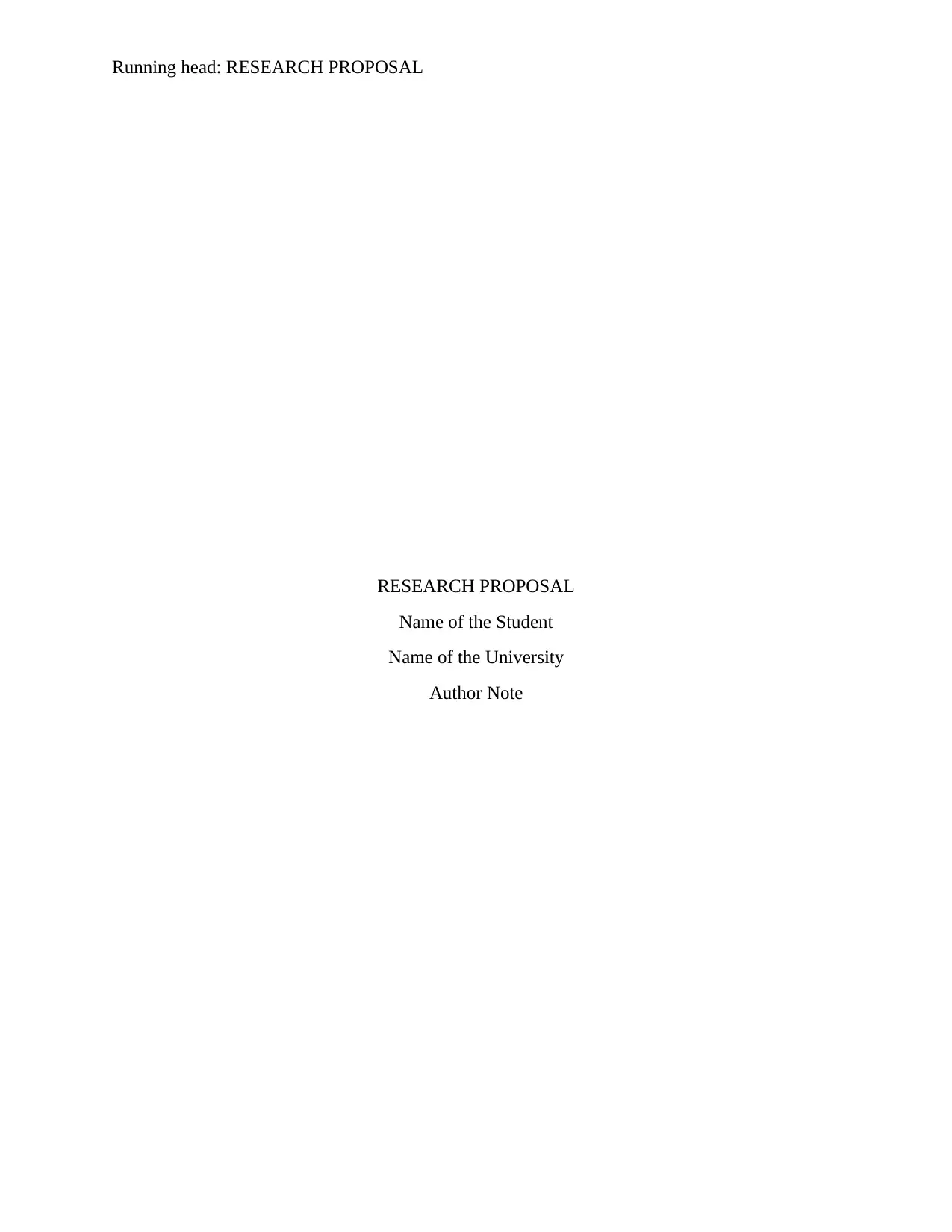
Running head: RESEARCH PROPOSAL
RESEARCH PROPOSAL
Name of the Student
Name of the University
Author Note
RESEARCH PROPOSAL
Name of the Student
Name of the University
Author Note
Paraphrase This Document
Need a fresh take? Get an instant paraphrase of this document with our AI Paraphraser
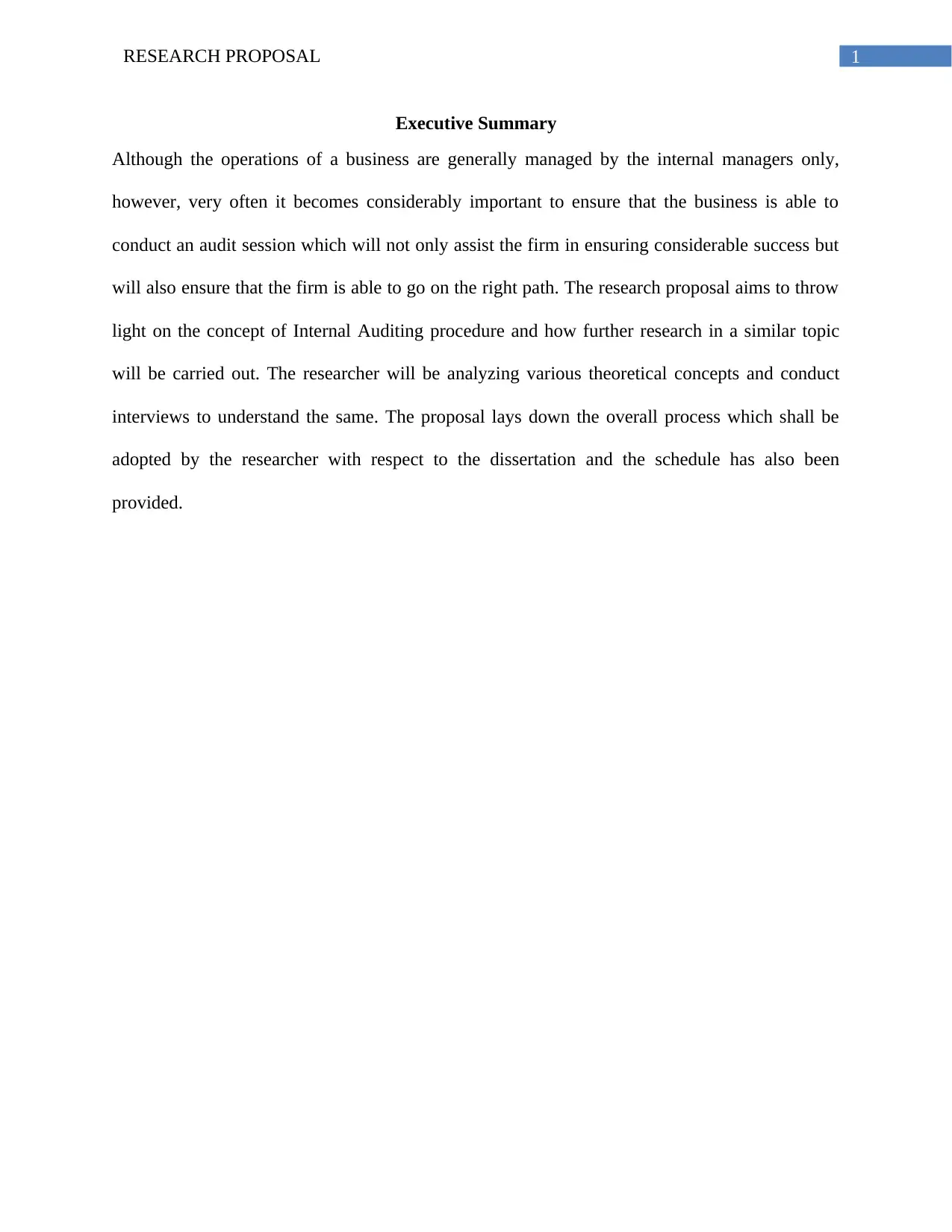
1RESEARCH PROPOSAL
Executive Summary
Although the operations of a business are generally managed by the internal managers only,
however, very often it becomes considerably important to ensure that the business is able to
conduct an audit session which will not only assist the firm in ensuring considerable success but
will also ensure that the firm is able to go on the right path. The research proposal aims to throw
light on the concept of Internal Auditing procedure and how further research in a similar topic
will be carried out. The researcher will be analyzing various theoretical concepts and conduct
interviews to understand the same. The proposal lays down the overall process which shall be
adopted by the researcher with respect to the dissertation and the schedule has also been
provided.
Executive Summary
Although the operations of a business are generally managed by the internal managers only,
however, very often it becomes considerably important to ensure that the business is able to
conduct an audit session which will not only assist the firm in ensuring considerable success but
will also ensure that the firm is able to go on the right path. The research proposal aims to throw
light on the concept of Internal Auditing procedure and how further research in a similar topic
will be carried out. The researcher will be analyzing various theoretical concepts and conduct
interviews to understand the same. The proposal lays down the overall process which shall be
adopted by the researcher with respect to the dissertation and the schedule has also been
provided.
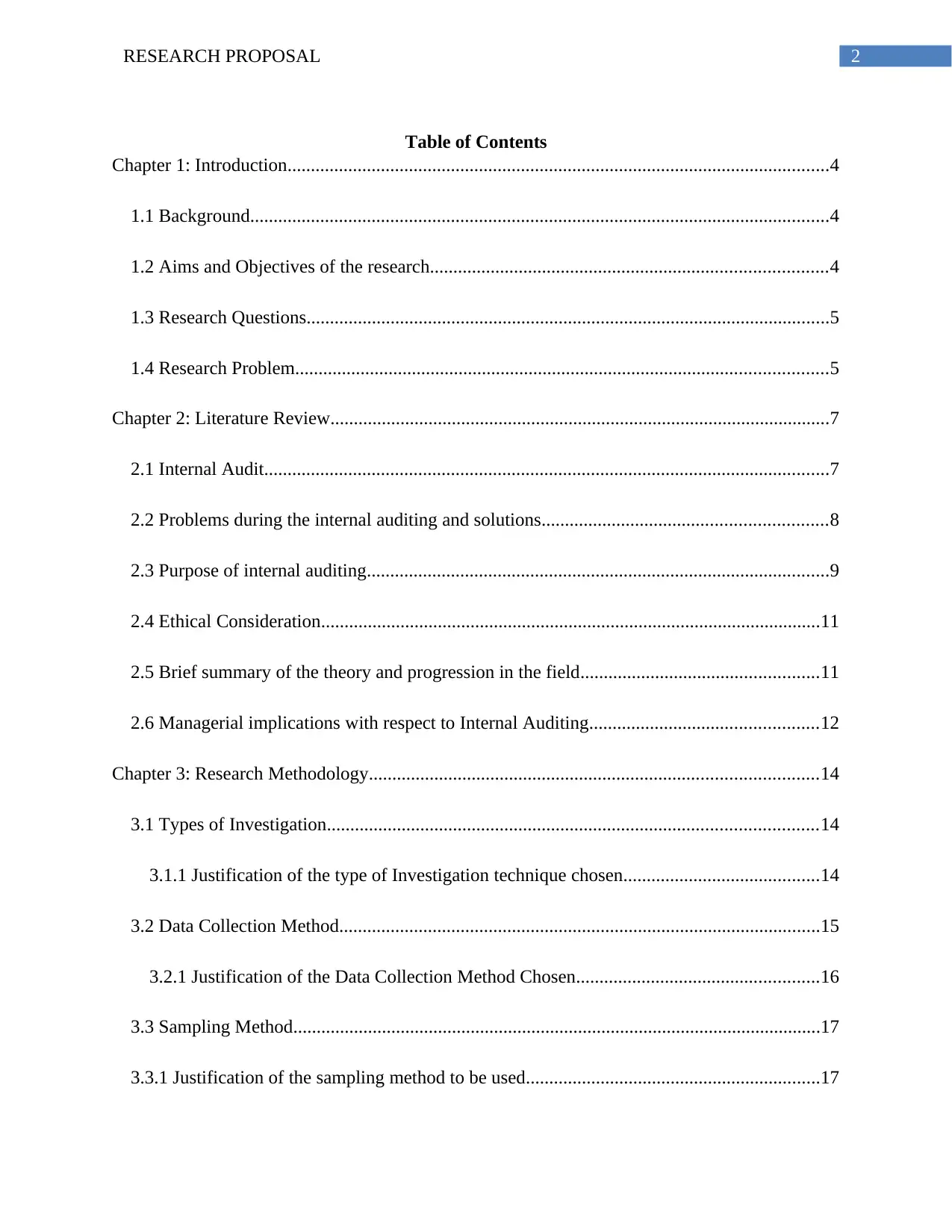
2RESEARCH PROPOSAL
Table of Contents
Chapter 1: Introduction....................................................................................................................4
1.1 Background............................................................................................................................4
1.2 Aims and Objectives of the research.....................................................................................4
1.3 Research Questions................................................................................................................5
1.4 Research Problem..................................................................................................................5
Chapter 2: Literature Review...........................................................................................................7
2.1 Internal Audit.........................................................................................................................7
2.2 Problems during the internal auditing and solutions.............................................................8
2.3 Purpose of internal auditing...................................................................................................9
2.4 Ethical Consideration...........................................................................................................11
2.5 Brief summary of the theory and progression in the field...................................................11
2.6 Managerial implications with respect to Internal Auditing.................................................12
Chapter 3: Research Methodology................................................................................................14
3.1 Types of Investigation.........................................................................................................14
3.1.1 Justification of the type of Investigation technique chosen..........................................14
3.2 Data Collection Method.......................................................................................................15
3.2.1 Justification of the Data Collection Method Chosen....................................................16
3.3 Sampling Method.................................................................................................................17
3.3.1 Justification of the sampling method to be used...............................................................17
Table of Contents
Chapter 1: Introduction....................................................................................................................4
1.1 Background............................................................................................................................4
1.2 Aims and Objectives of the research.....................................................................................4
1.3 Research Questions................................................................................................................5
1.4 Research Problem..................................................................................................................5
Chapter 2: Literature Review...........................................................................................................7
2.1 Internal Audit.........................................................................................................................7
2.2 Problems during the internal auditing and solutions.............................................................8
2.3 Purpose of internal auditing...................................................................................................9
2.4 Ethical Consideration...........................................................................................................11
2.5 Brief summary of the theory and progression in the field...................................................11
2.6 Managerial implications with respect to Internal Auditing.................................................12
Chapter 3: Research Methodology................................................................................................14
3.1 Types of Investigation.........................................................................................................14
3.1.1 Justification of the type of Investigation technique chosen..........................................14
3.2 Data Collection Method.......................................................................................................15
3.2.1 Justification of the Data Collection Method Chosen....................................................16
3.3 Sampling Method.................................................................................................................17
3.3.1 Justification of the sampling method to be used...............................................................17
⊘ This is a preview!⊘
Do you want full access?
Subscribe today to unlock all pages.

Trusted by 1+ million students worldwide
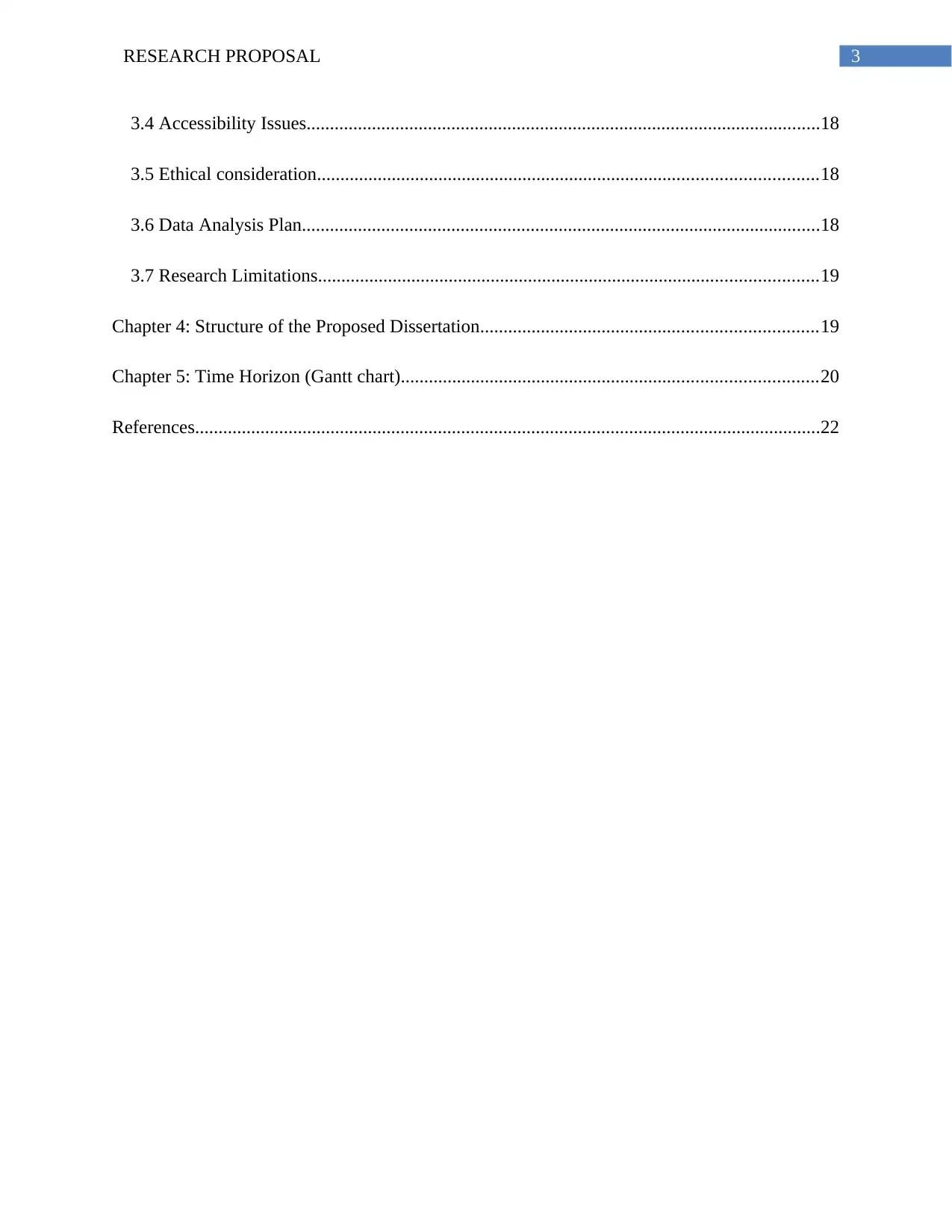
3RESEARCH PROPOSAL
3.4 Accessibility Issues..............................................................................................................18
3.5 Ethical consideration...........................................................................................................18
3.6 Data Analysis Plan...............................................................................................................18
3.7 Research Limitations...........................................................................................................19
Chapter 4: Structure of the Proposed Dissertation........................................................................19
Chapter 5: Time Horizon (Gantt chart).........................................................................................20
References......................................................................................................................................22
3.4 Accessibility Issues..............................................................................................................18
3.5 Ethical consideration...........................................................................................................18
3.6 Data Analysis Plan...............................................................................................................18
3.7 Research Limitations...........................................................................................................19
Chapter 4: Structure of the Proposed Dissertation........................................................................19
Chapter 5: Time Horizon (Gantt chart).........................................................................................20
References......................................................................................................................................22
Paraphrase This Document
Need a fresh take? Get an instant paraphrase of this document with our AI Paraphraser
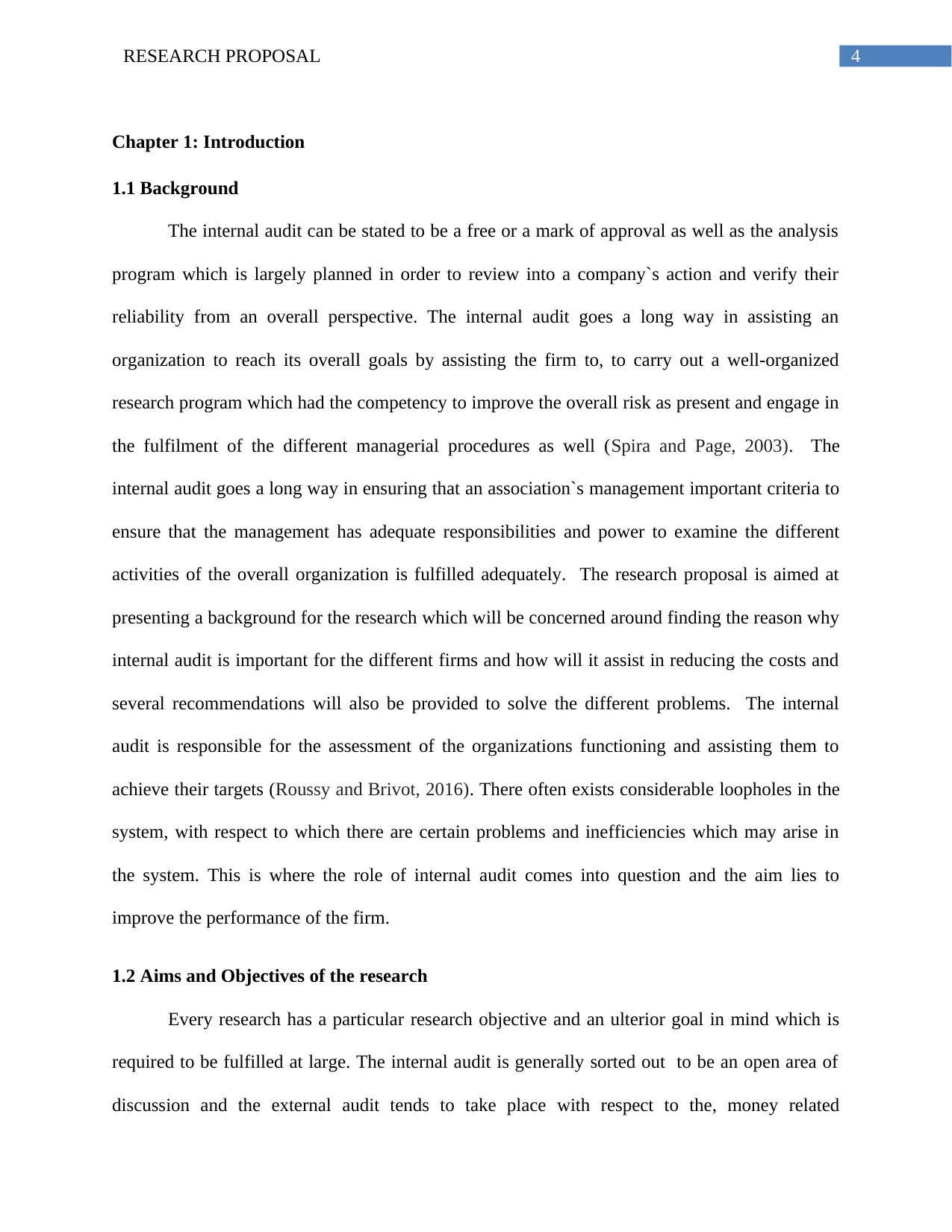
4RESEARCH PROPOSAL
Chapter 1: Introduction
1.1 Background
The internal audit can be stated to be a free or a mark of approval as well as the analysis
program which is largely planned in order to review into a company`s action and verify their
reliability from an overall perspective. The internal audit goes a long way in assisting an
organization to reach its overall goals by assisting the firm to, to carry out a well-organized
research program which had the competency to improve the overall risk as present and engage in
the fulfilment of the different managerial procedures as well (Spira and Page, 2003). The
internal audit goes a long way in ensuring that an association`s management important criteria to
ensure that the management has adequate responsibilities and power to examine the different
activities of the overall organization is fulfilled adequately. The research proposal is aimed at
presenting a background for the research which will be concerned around finding the reason why
internal audit is important for the different firms and how will it assist in reducing the costs and
several recommendations will also be provided to solve the different problems. The internal
audit is responsible for the assessment of the organizations functioning and assisting them to
achieve their targets (Roussy and Brivot, 2016). There often exists considerable loopholes in the
system, with respect to which there are certain problems and inefficiencies which may arise in
the system. This is where the role of internal audit comes into question and the aim lies to
improve the performance of the firm.
1.2 Aims and Objectives of the research
Every research has a particular research objective and an ulterior goal in mind which is
required to be fulfilled at large. The internal audit is generally sorted out to be an open area of
discussion and the external audit tends to take place with respect to the, money related
Chapter 1: Introduction
1.1 Background
The internal audit can be stated to be a free or a mark of approval as well as the analysis
program which is largely planned in order to review into a company`s action and verify their
reliability from an overall perspective. The internal audit goes a long way in assisting an
organization to reach its overall goals by assisting the firm to, to carry out a well-organized
research program which had the competency to improve the overall risk as present and engage in
the fulfilment of the different managerial procedures as well (Spira and Page, 2003). The
internal audit goes a long way in ensuring that an association`s management important criteria to
ensure that the management has adequate responsibilities and power to examine the different
activities of the overall organization is fulfilled adequately. The research proposal is aimed at
presenting a background for the research which will be concerned around finding the reason why
internal audit is important for the different firms and how will it assist in reducing the costs and
several recommendations will also be provided to solve the different problems. The internal
audit is responsible for the assessment of the organizations functioning and assisting them to
achieve their targets (Roussy and Brivot, 2016). There often exists considerable loopholes in the
system, with respect to which there are certain problems and inefficiencies which may arise in
the system. This is where the role of internal audit comes into question and the aim lies to
improve the performance of the firm.
1.2 Aims and Objectives of the research
Every research has a particular research objective and an ulterior goal in mind which is
required to be fulfilled at large. The internal audit is generally sorted out to be an open area of
discussion and the external audit tends to take place with respect to the, money related
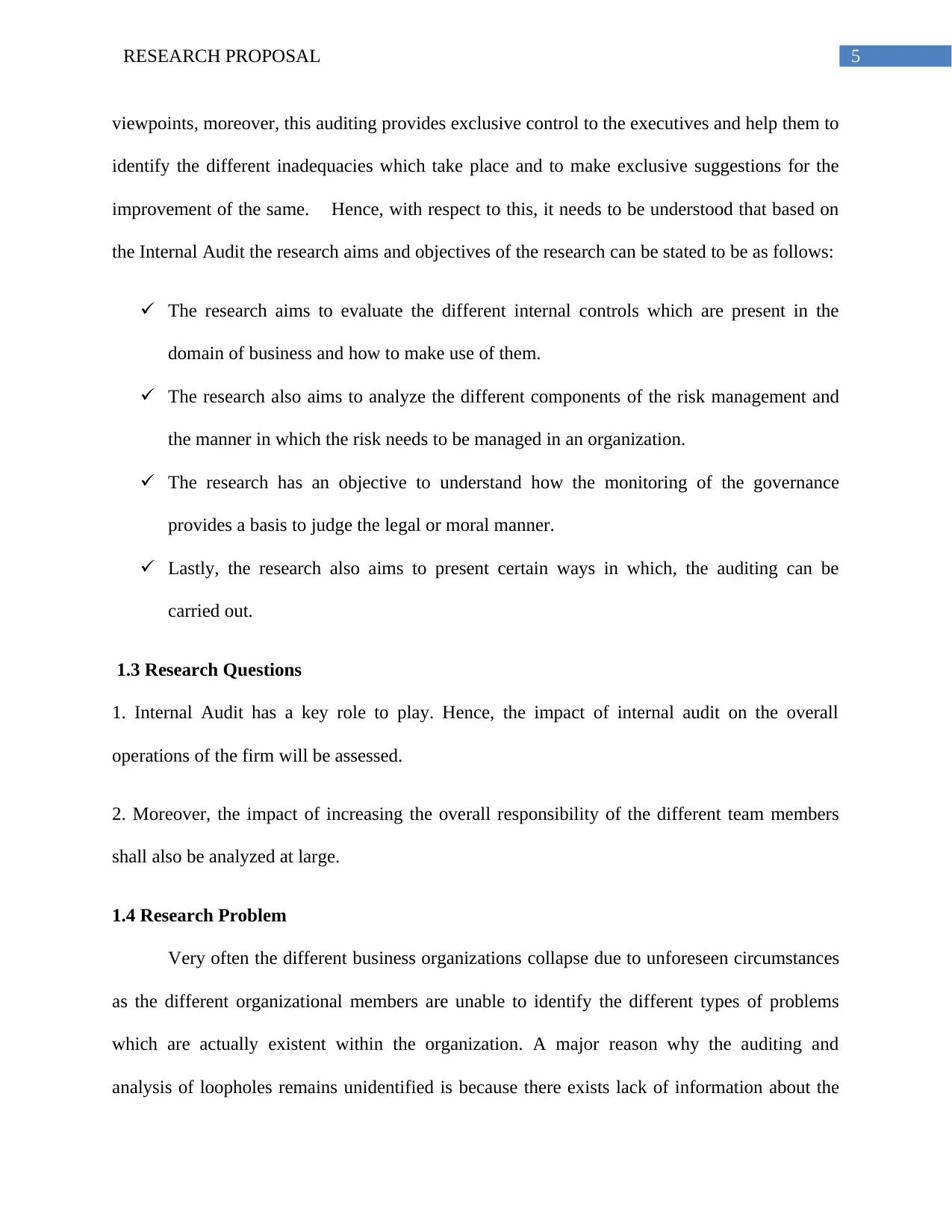
5RESEARCH PROPOSAL
viewpoints, moreover, this auditing provides exclusive control to the executives and help them to
identify the different inadequacies which take place and to make exclusive suggestions for the
improvement of the same. Hence, with respect to this, it needs to be understood that based on
the Internal Audit the research aims and objectives of the research can be stated to be as follows:
The research aims to evaluate the different internal controls which are present in the
domain of business and how to make use of them.
The research also aims to analyze the different components of the risk management and
the manner in which the risk needs to be managed in an organization.
The research has an objective to understand how the monitoring of the governance
provides a basis to judge the legal or moral manner.
Lastly, the research also aims to present certain ways in which, the auditing can be
carried out.
1.3 Research Questions
1. Internal Audit has a key role to play. Hence, the impact of internal audit on the overall
operations of the firm will be assessed.
2. Moreover, the impact of increasing the overall responsibility of the different team members
shall also be analyzed at large.
1.4 Research Problem
Very often the different business organizations collapse due to unforeseen circumstances
as the different organizational members are unable to identify the different types of problems
which are actually existent within the organization. A major reason why the auditing and
analysis of loopholes remains unidentified is because there exists lack of information about the
viewpoints, moreover, this auditing provides exclusive control to the executives and help them to
identify the different inadequacies which take place and to make exclusive suggestions for the
improvement of the same. Hence, with respect to this, it needs to be understood that based on
the Internal Audit the research aims and objectives of the research can be stated to be as follows:
The research aims to evaluate the different internal controls which are present in the
domain of business and how to make use of them.
The research also aims to analyze the different components of the risk management and
the manner in which the risk needs to be managed in an organization.
The research has an objective to understand how the monitoring of the governance
provides a basis to judge the legal or moral manner.
Lastly, the research also aims to present certain ways in which, the auditing can be
carried out.
1.3 Research Questions
1. Internal Audit has a key role to play. Hence, the impact of internal audit on the overall
operations of the firm will be assessed.
2. Moreover, the impact of increasing the overall responsibility of the different team members
shall also be analyzed at large.
1.4 Research Problem
Very often the different business organizations collapse due to unforeseen circumstances
as the different organizational members are unable to identify the different types of problems
which are actually existent within the organization. A major reason why the auditing and
analysis of loopholes remains unidentified is because there exists lack of information about the
⊘ This is a preview!⊘
Do you want full access?
Subscribe today to unlock all pages.

Trusted by 1+ million students worldwide
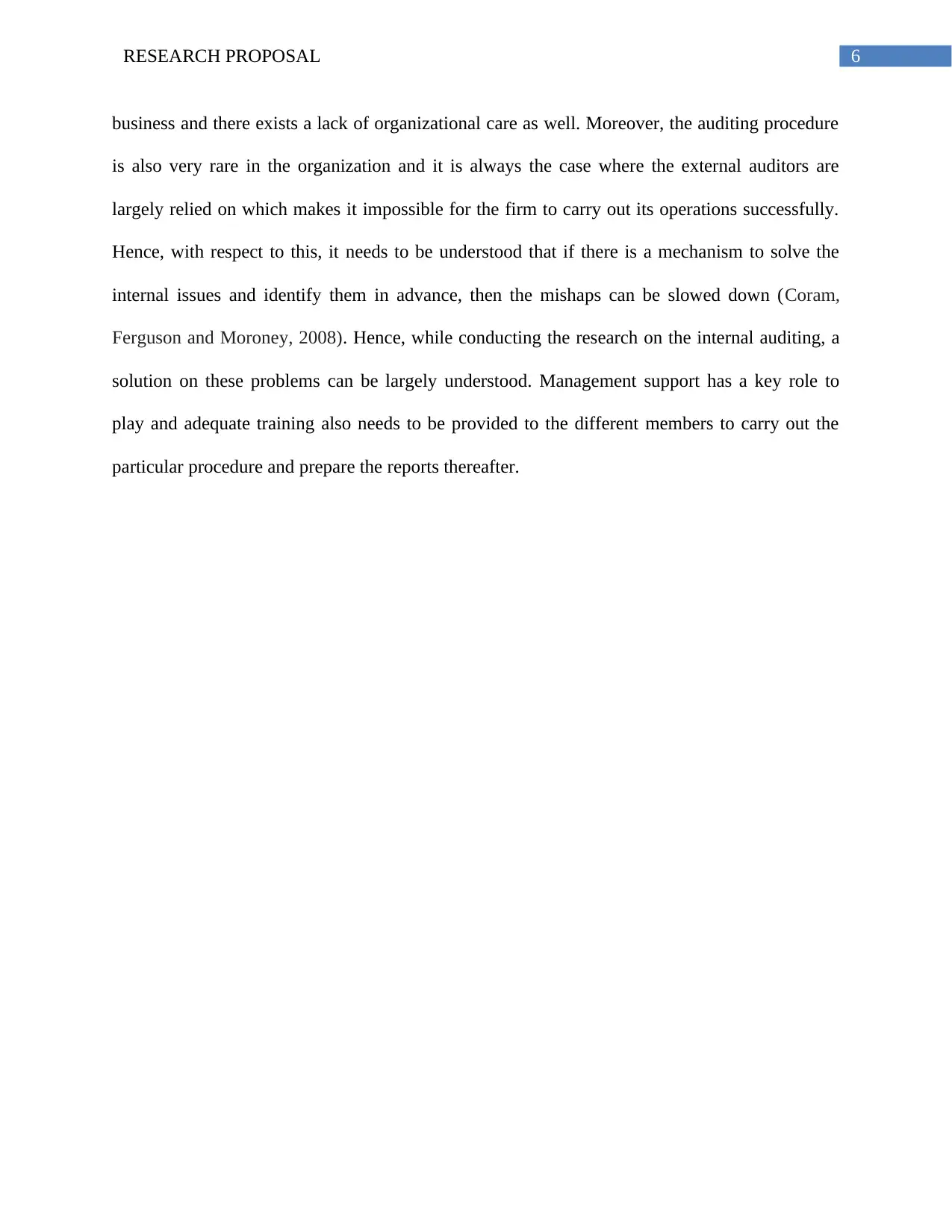
6RESEARCH PROPOSAL
business and there exists a lack of organizational care as well. Moreover, the auditing procedure
is also very rare in the organization and it is always the case where the external auditors are
largely relied on which makes it impossible for the firm to carry out its operations successfully.
Hence, with respect to this, it needs to be understood that if there is a mechanism to solve the
internal issues and identify them in advance, then the mishaps can be slowed down (Coram,
Ferguson and Moroney, 2008). Hence, while conducting the research on the internal auditing, a
solution on these problems can be largely understood. Management support has a key role to
play and adequate training also needs to be provided to the different members to carry out the
particular procedure and prepare the reports thereafter.
business and there exists a lack of organizational care as well. Moreover, the auditing procedure
is also very rare in the organization and it is always the case where the external auditors are
largely relied on which makes it impossible for the firm to carry out its operations successfully.
Hence, with respect to this, it needs to be understood that if there is a mechanism to solve the
internal issues and identify them in advance, then the mishaps can be slowed down (Coram,
Ferguson and Moroney, 2008). Hence, while conducting the research on the internal auditing, a
solution on these problems can be largely understood. Management support has a key role to
play and adequate training also needs to be provided to the different members to carry out the
particular procedure and prepare the reports thereafter.
Paraphrase This Document
Need a fresh take? Get an instant paraphrase of this document with our AI Paraphraser
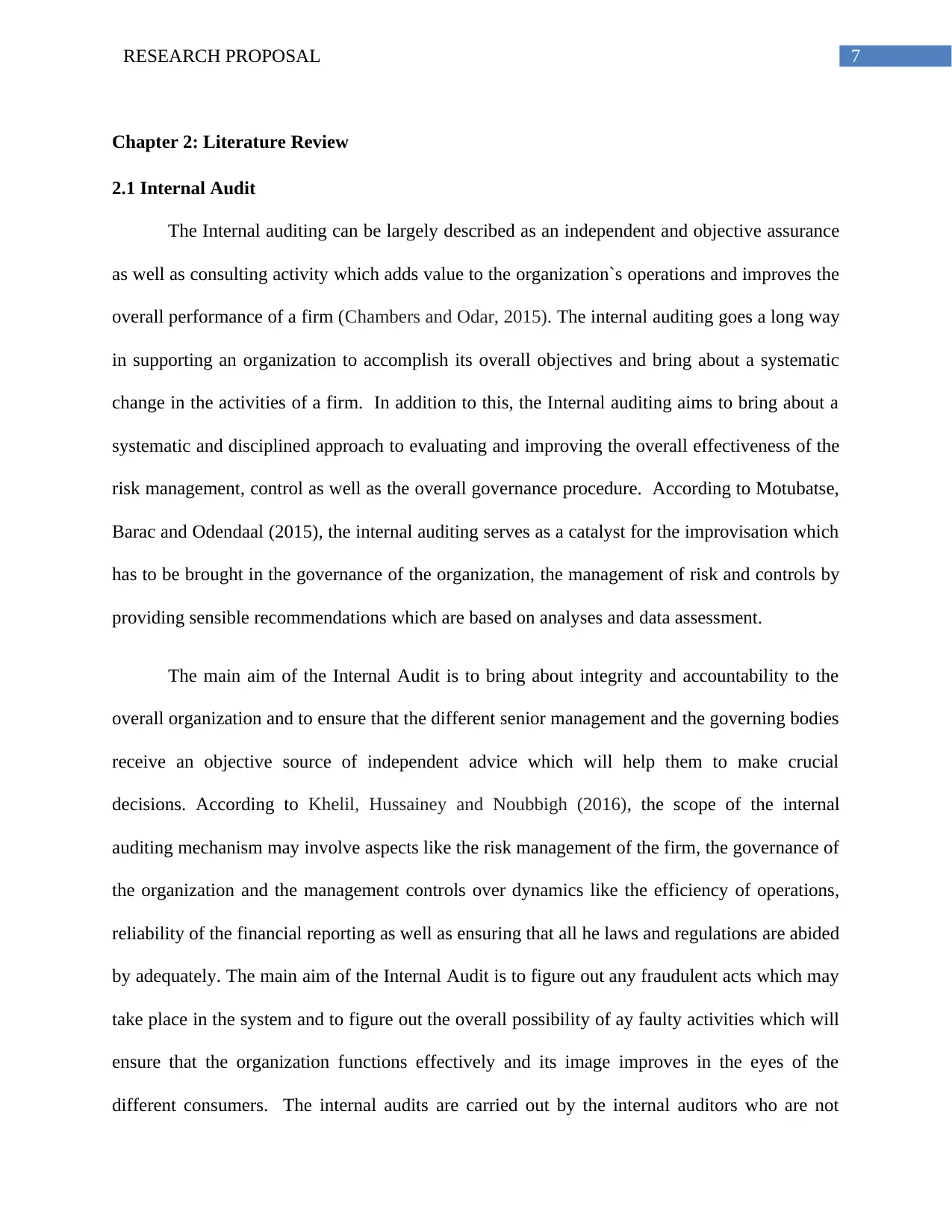
7RESEARCH PROPOSAL
Chapter 2: Literature Review
2.1 Internal Audit
The Internal auditing can be largely described as an independent and objective assurance
as well as consulting activity which adds value to the organization`s operations and improves the
overall performance of a firm (Chambers and Odar, 2015). The internal auditing goes a long way
in supporting an organization to accomplish its overall objectives and bring about a systematic
change in the activities of a firm. In addition to this, the Internal auditing aims to bring about a
systematic and disciplined approach to evaluating and improving the overall effectiveness of the
risk management, control as well as the overall governance procedure. According to Motubatse,
Barac and Odendaal (2015), the internal auditing serves as a catalyst for the improvisation which
has to be brought in the governance of the organization, the management of risk and controls by
providing sensible recommendations which are based on analyses and data assessment.
The main aim of the Internal Audit is to bring about integrity and accountability to the
overall organization and to ensure that the different senior management and the governing bodies
receive an objective source of independent advice which will help them to make crucial
decisions. According to Khelil, Hussainey and Noubbigh (2016), the scope of the internal
auditing mechanism may involve aspects like the risk management of the firm, the governance of
the organization and the management controls over dynamics like the efficiency of operations,
reliability of the financial reporting as well as ensuring that all he laws and regulations are abided
by adequately. The main aim of the Internal Audit is to figure out any fraudulent acts which may
take place in the system and to figure out the overall possibility of ay faulty activities which will
ensure that the organization functions effectively and its image improves in the eyes of the
different consumers. The internal audits are carried out by the internal auditors who are not
Chapter 2: Literature Review
2.1 Internal Audit
The Internal auditing can be largely described as an independent and objective assurance
as well as consulting activity which adds value to the organization`s operations and improves the
overall performance of a firm (Chambers and Odar, 2015). The internal auditing goes a long way
in supporting an organization to accomplish its overall objectives and bring about a systematic
change in the activities of a firm. In addition to this, the Internal auditing aims to bring about a
systematic and disciplined approach to evaluating and improving the overall effectiveness of the
risk management, control as well as the overall governance procedure. According to Motubatse,
Barac and Odendaal (2015), the internal auditing serves as a catalyst for the improvisation which
has to be brought in the governance of the organization, the management of risk and controls by
providing sensible recommendations which are based on analyses and data assessment.
The main aim of the Internal Audit is to bring about integrity and accountability to the
overall organization and to ensure that the different senior management and the governing bodies
receive an objective source of independent advice which will help them to make crucial
decisions. According to Khelil, Hussainey and Noubbigh (2016), the scope of the internal
auditing mechanism may involve aspects like the risk management of the firm, the governance of
the organization and the management controls over dynamics like the efficiency of operations,
reliability of the financial reporting as well as ensuring that all he laws and regulations are abided
by adequately. The main aim of the Internal Audit is to figure out any fraudulent acts which may
take place in the system and to figure out the overall possibility of ay faulty activities which will
ensure that the organization functions effectively and its image improves in the eyes of the
different consumers. The internal audits are carried out by the internal auditors who are not
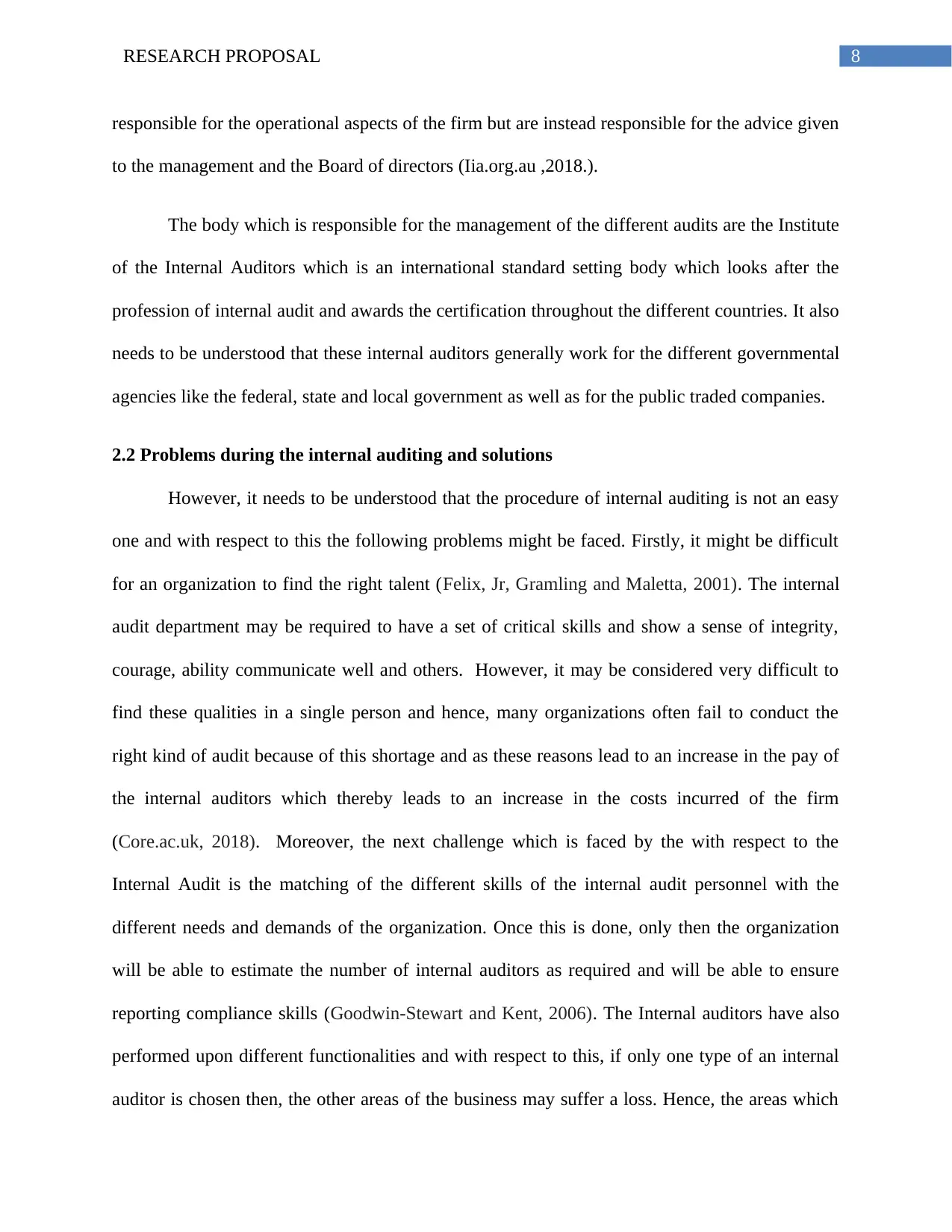
8RESEARCH PROPOSAL
responsible for the operational aspects of the firm but are instead responsible for the advice given
to the management and the Board of directors (Iia.org.au ,2018.).
The body which is responsible for the management of the different audits are the Institute
of the Internal Auditors which is an international standard setting body which looks after the
profession of internal audit and awards the certification throughout the different countries. It also
needs to be understood that these internal auditors generally work for the different governmental
agencies like the federal, state and local government as well as for the public traded companies.
2.2 Problems during the internal auditing and solutions
However, it needs to be understood that the procedure of internal auditing is not an easy
one and with respect to this the following problems might be faced. Firstly, it might be difficult
for an organization to find the right talent (Felix, Jr, Gramling and Maletta, 2001). The internal
audit department may be required to have a set of critical skills and show a sense of integrity,
courage, ability communicate well and others. However, it may be considered very difficult to
find these qualities in a single person and hence, many organizations often fail to conduct the
right kind of audit because of this shortage and as these reasons lead to an increase in the pay of
the internal auditors which thereby leads to an increase in the costs incurred of the firm
(Core.ac.uk, 2018). Moreover, the next challenge which is faced by the with respect to the
Internal Audit is the matching of the different skills of the internal audit personnel with the
different needs and demands of the organization. Once this is done, only then the organization
will be able to estimate the number of internal auditors as required and will be able to ensure
reporting compliance skills (Goodwin‐Stewart and Kent, 2006). The Internal auditors have also
performed upon different functionalities and with respect to this, if only one type of an internal
auditor is chosen then, the other areas of the business may suffer a loss. Hence, the areas which
responsible for the operational aspects of the firm but are instead responsible for the advice given
to the management and the Board of directors (Iia.org.au ,2018.).
The body which is responsible for the management of the different audits are the Institute
of the Internal Auditors which is an international standard setting body which looks after the
profession of internal audit and awards the certification throughout the different countries. It also
needs to be understood that these internal auditors generally work for the different governmental
agencies like the federal, state and local government as well as for the public traded companies.
2.2 Problems during the internal auditing and solutions
However, it needs to be understood that the procedure of internal auditing is not an easy
one and with respect to this the following problems might be faced. Firstly, it might be difficult
for an organization to find the right talent (Felix, Jr, Gramling and Maletta, 2001). The internal
audit department may be required to have a set of critical skills and show a sense of integrity,
courage, ability communicate well and others. However, it may be considered very difficult to
find these qualities in a single person and hence, many organizations often fail to conduct the
right kind of audit because of this shortage and as these reasons lead to an increase in the pay of
the internal auditors which thereby leads to an increase in the costs incurred of the firm
(Core.ac.uk, 2018). Moreover, the next challenge which is faced by the with respect to the
Internal Audit is the matching of the different skills of the internal audit personnel with the
different needs and demands of the organization. Once this is done, only then the organization
will be able to estimate the number of internal auditors as required and will be able to ensure
reporting compliance skills (Goodwin‐Stewart and Kent, 2006). The Internal auditors have also
performed upon different functionalities and with respect to this, if only one type of an internal
auditor is chosen then, the other areas of the business may suffer a loss. Hence, the areas which
⊘ This is a preview!⊘
Do you want full access?
Subscribe today to unlock all pages.

Trusted by 1+ million students worldwide
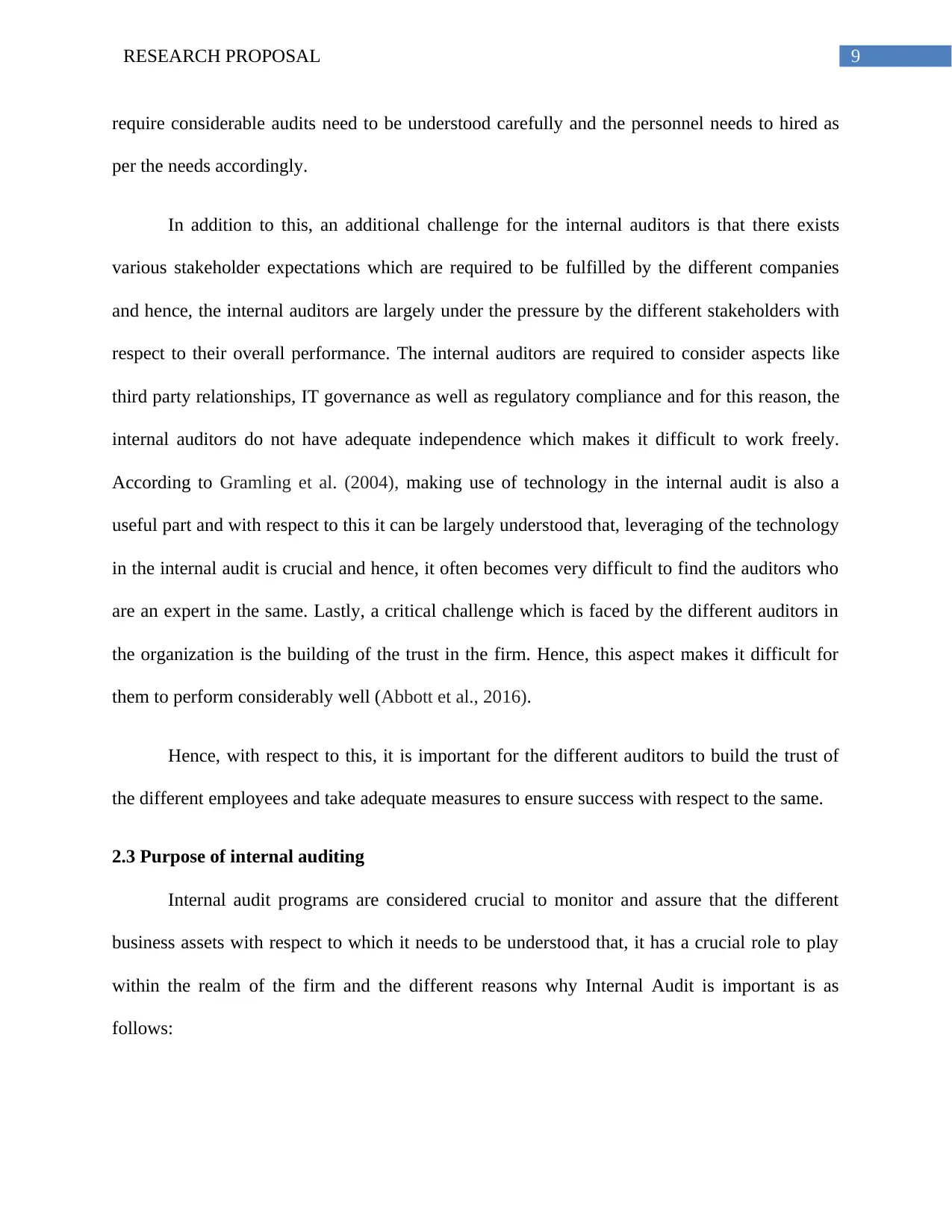
9RESEARCH PROPOSAL
require considerable audits need to be understood carefully and the personnel needs to hired as
per the needs accordingly.
In addition to this, an additional challenge for the internal auditors is that there exists
various stakeholder expectations which are required to be fulfilled by the different companies
and hence, the internal auditors are largely under the pressure by the different stakeholders with
respect to their overall performance. The internal auditors are required to consider aspects like
third party relationships, IT governance as well as regulatory compliance and for this reason, the
internal auditors do not have adequate independence which makes it difficult to work freely.
According to Gramling et al. (2004), making use of technology in the internal audit is also a
useful part and with respect to this it can be largely understood that, leveraging of the technology
in the internal audit is crucial and hence, it often becomes very difficult to find the auditors who
are an expert in the same. Lastly, a critical challenge which is faced by the different auditors in
the organization is the building of the trust in the firm. Hence, this aspect makes it difficult for
them to perform considerably well (Abbott et al., 2016).
Hence, with respect to this, it is important for the different auditors to build the trust of
the different employees and take adequate measures to ensure success with respect to the same.
2.3 Purpose of internal auditing
Internal audit programs are considered crucial to monitor and assure that the different
business assets with respect to which it needs to be understood that, it has a crucial role to play
within the realm of the firm and the different reasons why Internal Audit is important is as
follows:
require considerable audits need to be understood carefully and the personnel needs to hired as
per the needs accordingly.
In addition to this, an additional challenge for the internal auditors is that there exists
various stakeholder expectations which are required to be fulfilled by the different companies
and hence, the internal auditors are largely under the pressure by the different stakeholders with
respect to their overall performance. The internal auditors are required to consider aspects like
third party relationships, IT governance as well as regulatory compliance and for this reason, the
internal auditors do not have adequate independence which makes it difficult to work freely.
According to Gramling et al. (2004), making use of technology in the internal audit is also a
useful part and with respect to this it can be largely understood that, leveraging of the technology
in the internal audit is crucial and hence, it often becomes very difficult to find the auditors who
are an expert in the same. Lastly, a critical challenge which is faced by the different auditors in
the organization is the building of the trust in the firm. Hence, this aspect makes it difficult for
them to perform considerably well (Abbott et al., 2016).
Hence, with respect to this, it is important for the different auditors to build the trust of
the different employees and take adequate measures to ensure success with respect to the same.
2.3 Purpose of internal auditing
Internal audit programs are considered crucial to monitor and assure that the different
business assets with respect to which it needs to be understood that, it has a crucial role to play
within the realm of the firm and the different reasons why Internal Audit is important is as
follows:
Paraphrase This Document
Need a fresh take? Get an instant paraphrase of this document with our AI Paraphraser
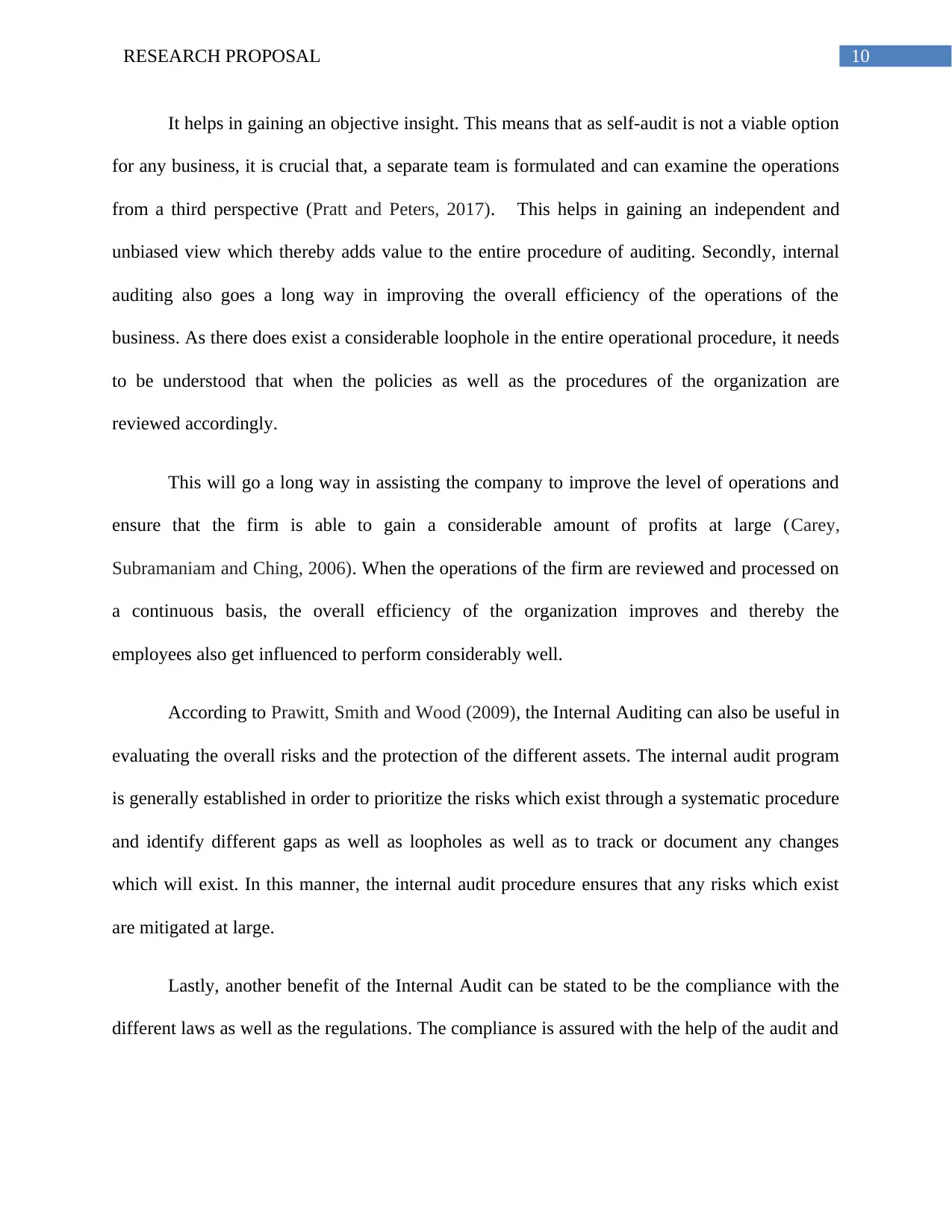
10RESEARCH PROPOSAL
It helps in gaining an objective insight. This means that as self-audit is not a viable option
for any business, it is crucial that, a separate team is formulated and can examine the operations
from a third perspective (Pratt and Peters, 2017). This helps in gaining an independent and
unbiased view which thereby adds value to the entire procedure of auditing. Secondly, internal
auditing also goes a long way in improving the overall efficiency of the operations of the
business. As there does exist a considerable loophole in the entire operational procedure, it needs
to be understood that when the policies as well as the procedures of the organization are
reviewed accordingly.
This will go a long way in assisting the company to improve the level of operations and
ensure that the firm is able to gain a considerable amount of profits at large (Carey,
Subramaniam and Ching, 2006). When the operations of the firm are reviewed and processed on
a continuous basis, the overall efficiency of the organization improves and thereby the
employees also get influenced to perform considerably well.
According to Prawitt, Smith and Wood (2009), the Internal Auditing can also be useful in
evaluating the overall risks and the protection of the different assets. The internal audit program
is generally established in order to prioritize the risks which exist through a systematic procedure
and identify different gaps as well as loopholes as well as to track or document any changes
which will exist. In this manner, the internal audit procedure ensures that any risks which exist
are mitigated at large.
Lastly, another benefit of the Internal Audit can be stated to be the compliance with the
different laws as well as the regulations. The compliance is assured with the help of the audit and
It helps in gaining an objective insight. This means that as self-audit is not a viable option
for any business, it is crucial that, a separate team is formulated and can examine the operations
from a third perspective (Pratt and Peters, 2017). This helps in gaining an independent and
unbiased view which thereby adds value to the entire procedure of auditing. Secondly, internal
auditing also goes a long way in improving the overall efficiency of the operations of the
business. As there does exist a considerable loophole in the entire operational procedure, it needs
to be understood that when the policies as well as the procedures of the organization are
reviewed accordingly.
This will go a long way in assisting the company to improve the level of operations and
ensure that the firm is able to gain a considerable amount of profits at large (Carey,
Subramaniam and Ching, 2006). When the operations of the firm are reviewed and processed on
a continuous basis, the overall efficiency of the organization improves and thereby the
employees also get influenced to perform considerably well.
According to Prawitt, Smith and Wood (2009), the Internal Auditing can also be useful in
evaluating the overall risks and the protection of the different assets. The internal audit program
is generally established in order to prioritize the risks which exist through a systematic procedure
and identify different gaps as well as loopholes as well as to track or document any changes
which will exist. In this manner, the internal audit procedure ensures that any risks which exist
are mitigated at large.
Lastly, another benefit of the Internal Audit can be stated to be the compliance with the
different laws as well as the regulations. The compliance is assured with the help of the audit and
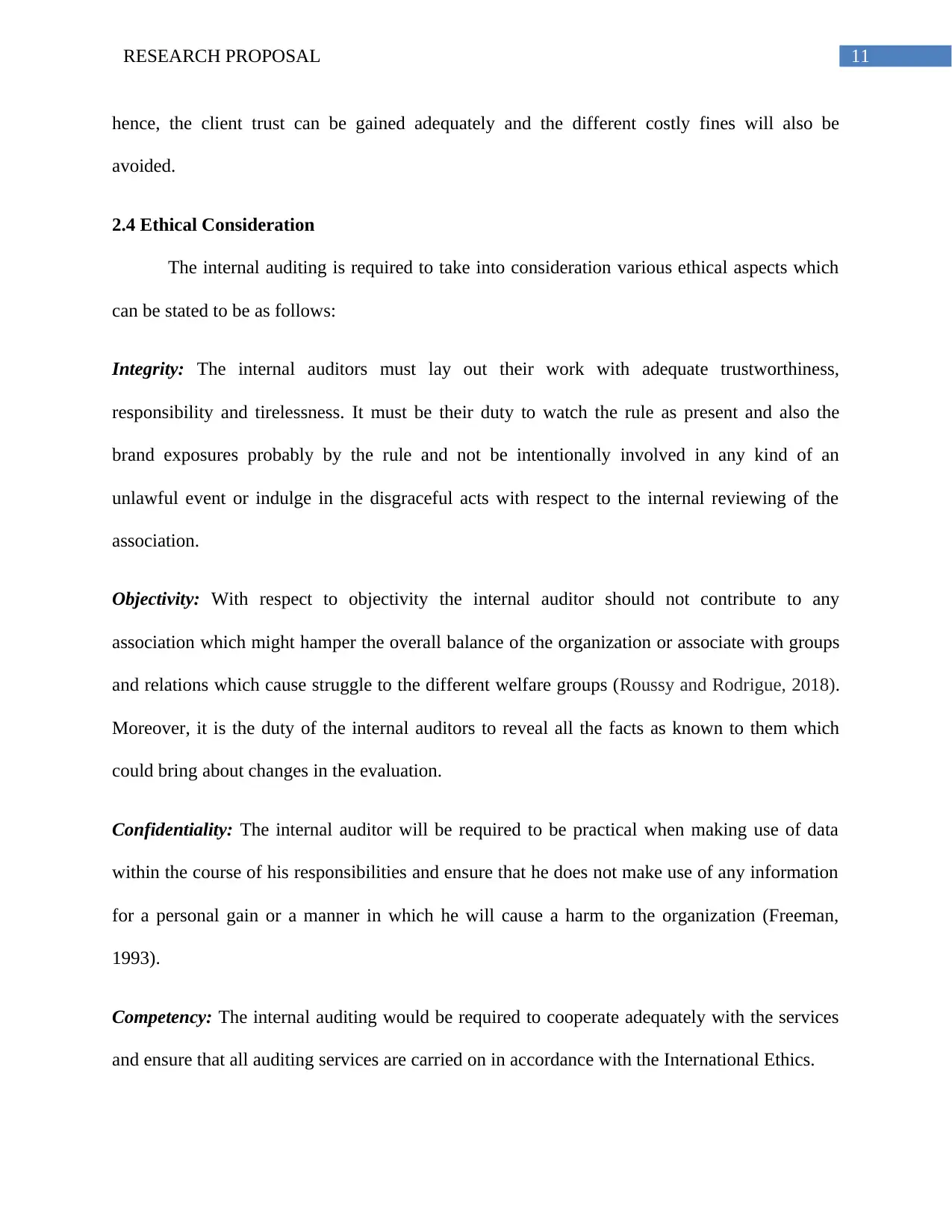
11RESEARCH PROPOSAL
hence, the client trust can be gained adequately and the different costly fines will also be
avoided.
2.4 Ethical Consideration
The internal auditing is required to take into consideration various ethical aspects which
can be stated to be as follows:
Integrity: The internal auditors must lay out their work with adequate trustworthiness,
responsibility and tirelessness. It must be their duty to watch the rule as present and also the
brand exposures probably by the rule and not be intentionally involved in any kind of an
unlawful event or indulge in the disgraceful acts with respect to the internal reviewing of the
association.
Objectivity: With respect to objectivity the internal auditor should not contribute to any
association which might hamper the overall balance of the organization or associate with groups
and relations which cause struggle to the different welfare groups (Roussy and Rodrigue, 2018).
Moreover, it is the duty of the internal auditors to reveal all the facts as known to them which
could bring about changes in the evaluation.
Confidentiality: The internal auditor will be required to be practical when making use of data
within the course of his responsibilities and ensure that he does not make use of any information
for a personal gain or a manner in which he will cause a harm to the organization (Freeman,
1993).
Competency: The internal auditing would be required to cooperate adequately with the services
and ensure that all auditing services are carried on in accordance with the International Ethics.
hence, the client trust can be gained adequately and the different costly fines will also be
avoided.
2.4 Ethical Consideration
The internal auditing is required to take into consideration various ethical aspects which
can be stated to be as follows:
Integrity: The internal auditors must lay out their work with adequate trustworthiness,
responsibility and tirelessness. It must be their duty to watch the rule as present and also the
brand exposures probably by the rule and not be intentionally involved in any kind of an
unlawful event or indulge in the disgraceful acts with respect to the internal reviewing of the
association.
Objectivity: With respect to objectivity the internal auditor should not contribute to any
association which might hamper the overall balance of the organization or associate with groups
and relations which cause struggle to the different welfare groups (Roussy and Rodrigue, 2018).
Moreover, it is the duty of the internal auditors to reveal all the facts as known to them which
could bring about changes in the evaluation.
Confidentiality: The internal auditor will be required to be practical when making use of data
within the course of his responsibilities and ensure that he does not make use of any information
for a personal gain or a manner in which he will cause a harm to the organization (Freeman,
1993).
Competency: The internal auditing would be required to cooperate adequately with the services
and ensure that all auditing services are carried on in accordance with the International Ethics.
⊘ This is a preview!⊘
Do you want full access?
Subscribe today to unlock all pages.

Trusted by 1+ million students worldwide
1 out of 26
Related Documents
Your All-in-One AI-Powered Toolkit for Academic Success.
+13062052269
info@desklib.com
Available 24*7 on WhatsApp / Email
![[object Object]](/_next/static/media/star-bottom.7253800d.svg)
Unlock your academic potential
Copyright © 2020–2025 A2Z Services. All Rights Reserved. Developed and managed by ZUCOL.





